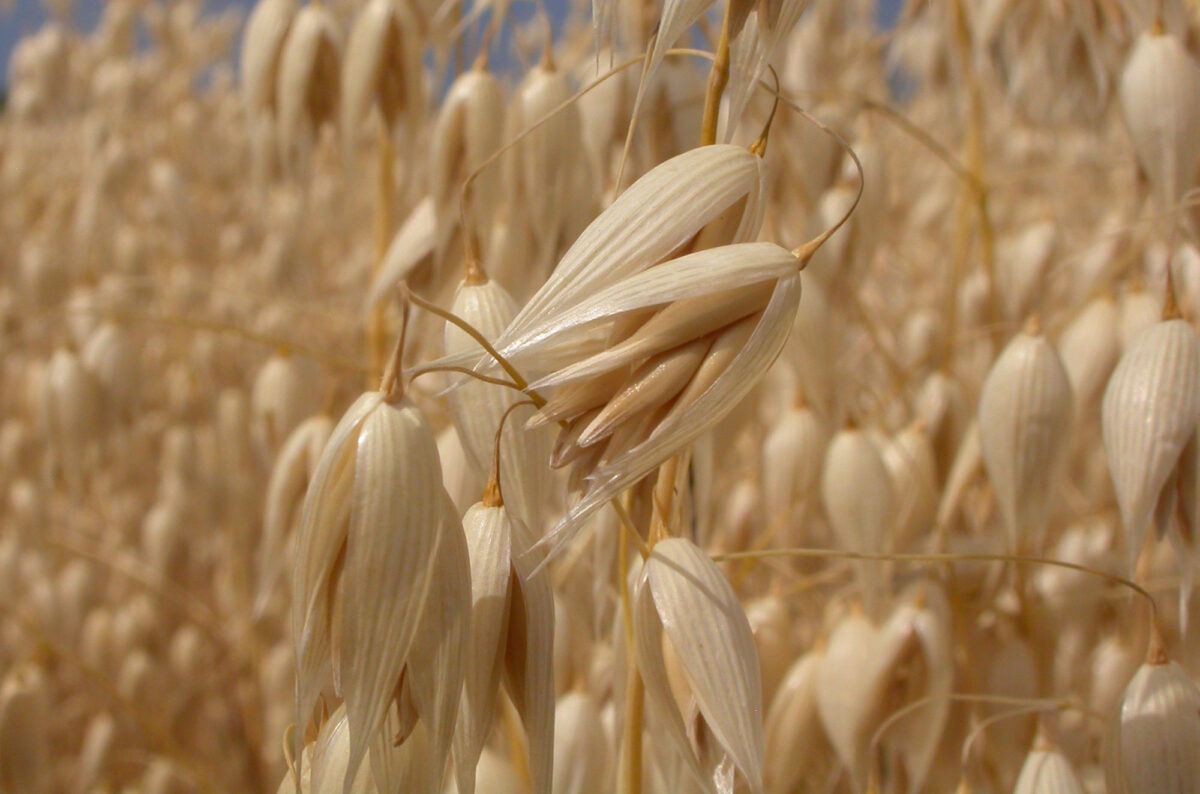Page snapshot: Introduction to the diversity and classification of grasses, including the major clades, the subfamilies, and selected tribes, genera, and species.
Topics covered on this page: Introduction; Early diverging groups (Anomochlooideae, Pharoideae, Puelioideae); BOP clade; Subfamily Oryzoideae; Subfamily Bambusoideae (bamboos); Subfamily Pooideae (cool-season grasses); PACMAD clade; Subfamily Aristidoideae; Subfamily Panicoideae; Subfamily Arundinoideae; Subfamily Micrairoideae; Subfamily Danthonioideae; Subfamily Chloridoideae; Resources.
Credits: Funded by the National Science Foundation. Any opinions, findings, and conclusions or recommendations expressed in this material are those of the author(s) and do not necessarily reflect the views of the National Science Foundation. Page by Elizabeth J. Hermsen (2022).
Updates: Page last updated January 11, 2023.
Image above: Oats (Avena sativa), cultivated in Idaho, U.S.A. Photo by Matt Lavin (flickr, Creative Commons Attribution-ShareAlike 2.0 Generic license, image cropped and resized).
Introduction
Grasses belong to the Grass Family, a group of plants with the scientific name Poaceae or Graminae. Grasses are the fifth-largest family of angiosperms (flowering plants), and the second-largest family of monocots after the orchid family (Orchidaceae). The grasses include three major groups, the early diverging lineages, the BOP clade, and the PACMAD clade. (A clade is a group made up an ancestor and all of its descendants.) The groups are divided into 12 subfamilies, which are themselves divided into tribes, genera, and species.
The subfamilies of grasses are discussed below. Familiar grasses in each subfamily are highlighted in order to illustrate the breadth of grass diversity and the high importance of grasses to humans.
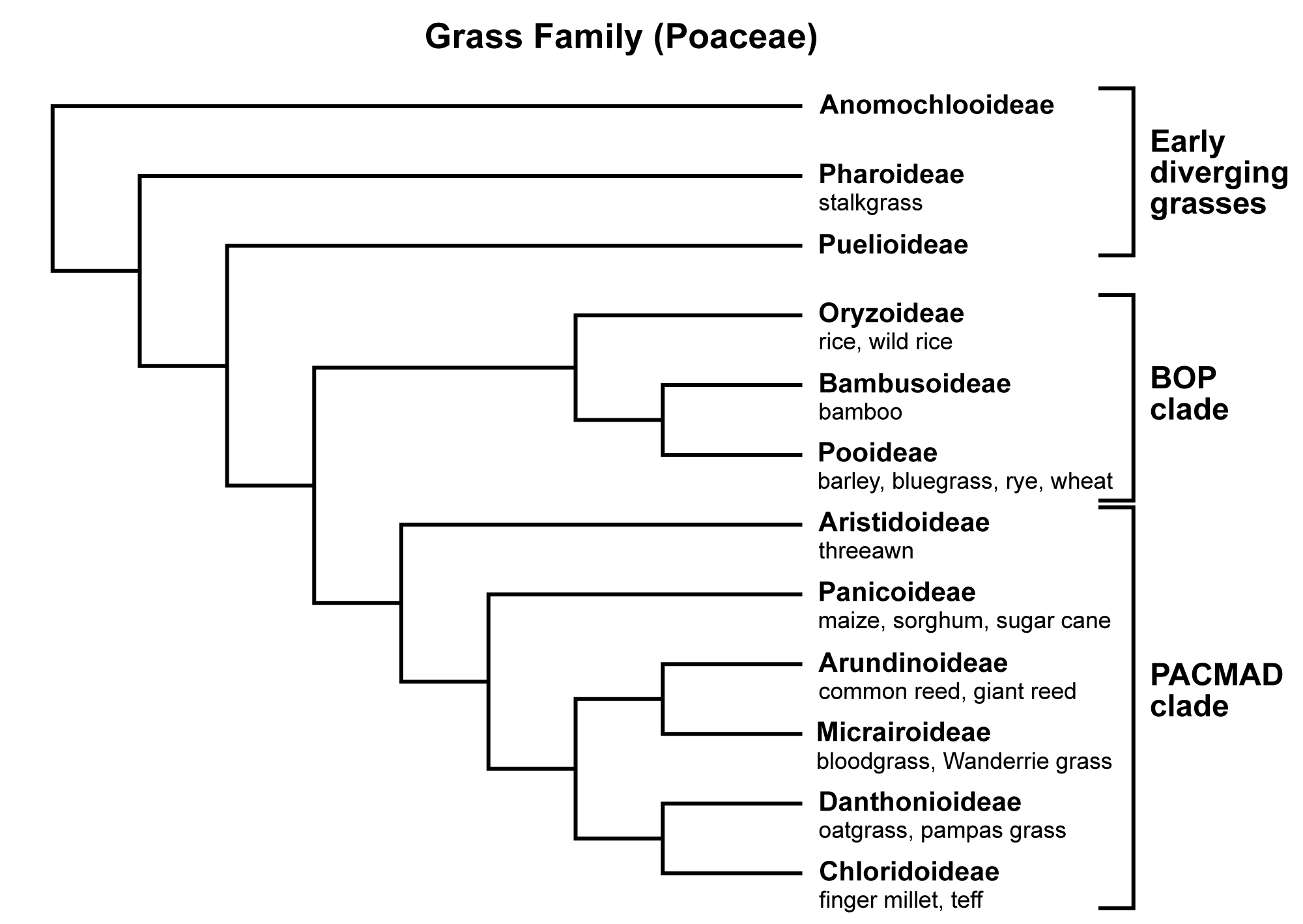
Simplified phylogenetic tree of the grass family (Poaceae) showing relationships among the subfamilies, with examples of grasses in each subfamily under the corresponding subfamily name. Diagram by Elizabeth J. Hermsen for Earth@Home, based on figure 1 in Soreng et al. (2017) Journal of Systematics and Evolution 53.
Early diverging grasses
The three early diverging subfamilies of grasses include forest grasses found primarily in tropical habitats. These subfamilies are Anomochlooideae, Pharoideae, and Puelioideae. All three subfamilies are very small, with about 7 genera and fewer than 30 species among them. The most widely distributed is Pharoideae, which in found across the tropics worldwide. Anomochlooideae is found only in the Americas, whereas Puelioideae is restricted to Africa. The basally diverging grasses are all thought to be C3 grasses. Anomochloodieae is the only subfamily of grasses that does not have spikelets.
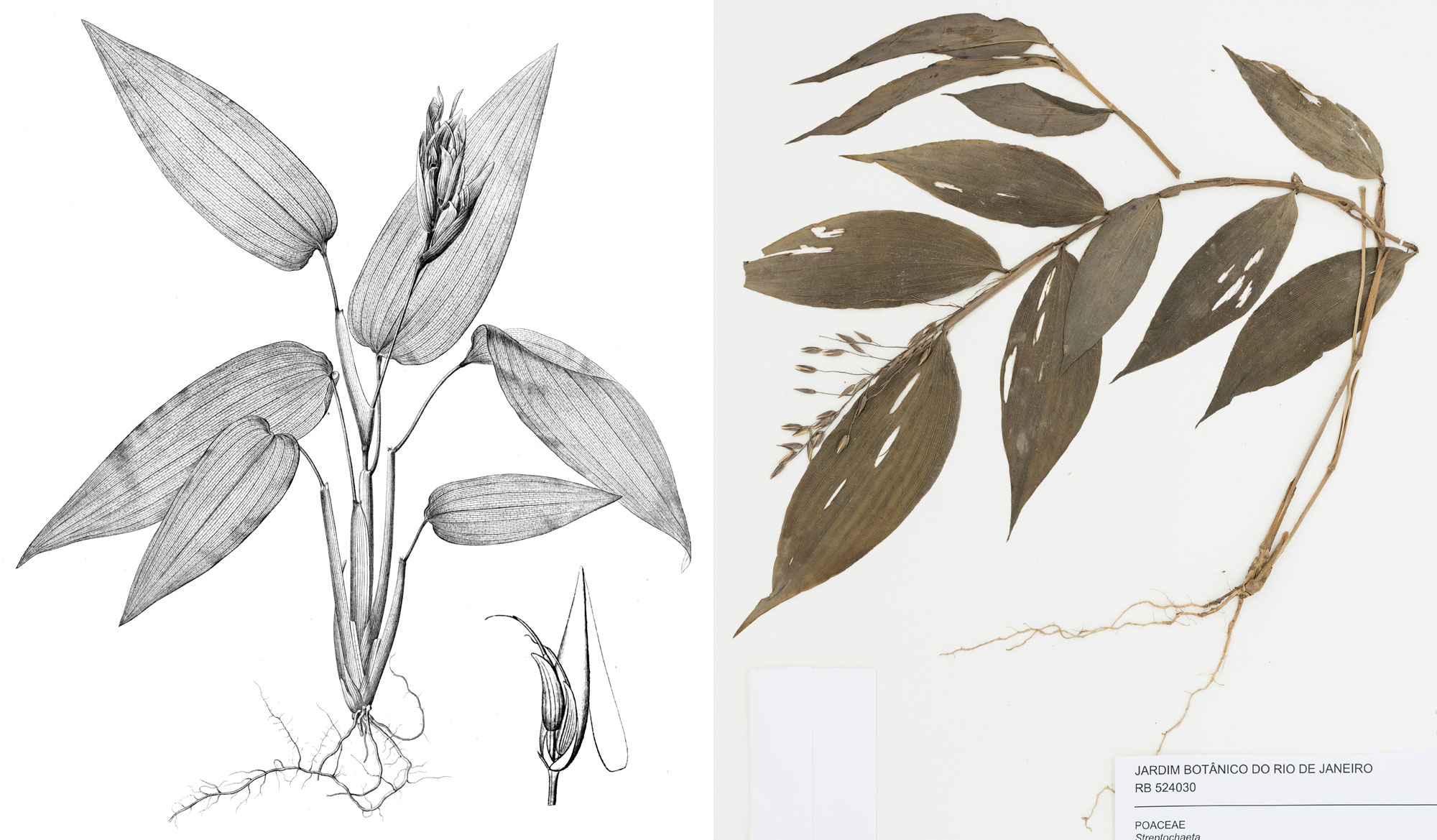
Anomochlooideae. Left: Illustration of Anomochloa marantoidea. Right: Herbarium specimen of Streptochaeta from Brazil. Illustration from Flora Brasiliensis, 1871 (CC0 1.0 Universal/public domain dedication). Right photo of NY02694557 by New York Botanical Garden (NYBG on GBIF.org, Creative Commons Attribution 4.0 International license, image cropped and resized).
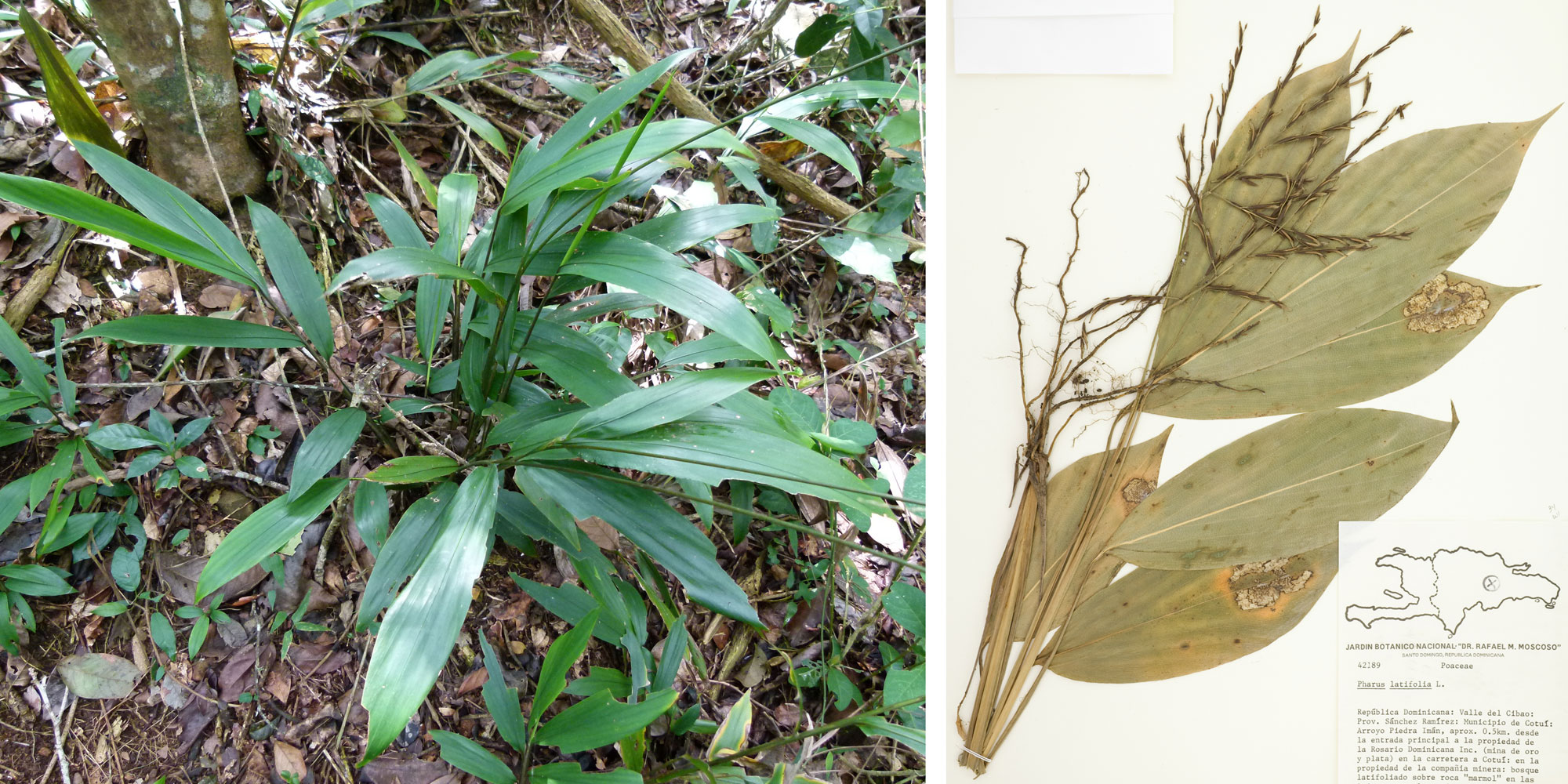
Stalkgrasses (Pharus, subfamily Pharoideae). Left: Creeping leafstalk grass (Pharus lappulaceus), Cuyón, Aibonito, Puerto Rico. Right: Herbarium specimen of Pharus latifolius from the Dominican Republic. Left photo by botanygirl (iNaturalist, Creative Commons Attribution 4.0 International license, image cropped and resized). Right photo of NY1606841 by New York Botanical Garden (NYBG on GBIF.org, Creative Commons Attribution 4.0 International license, image cropped and resized).
BOP clade
The "BOP" clade is named for the three subfamilies that make up the group: Bambusoideae, Oryzoideae, and Pooideae. All members of the BOP clade are C3 grasses. This group is sometimes also called the "BEP" clade, since an alternative name for Oryzoideae is Ehrhartoideae.
Subfamily Oryzoideae
Subfamily Oryzoideae has about 19 genera and 115 species in two tribes. This relatively small subfamily includes one very important cereal crop: rice (Oryza, especially Oryza sativa). Wild rice (Zizania), which is under much more limited cultivation and is also gathered from the wild, is in this subfamily as well. Examples of other members of this subfamily include cutgrass (Leersia) and watergrass (Luziola).
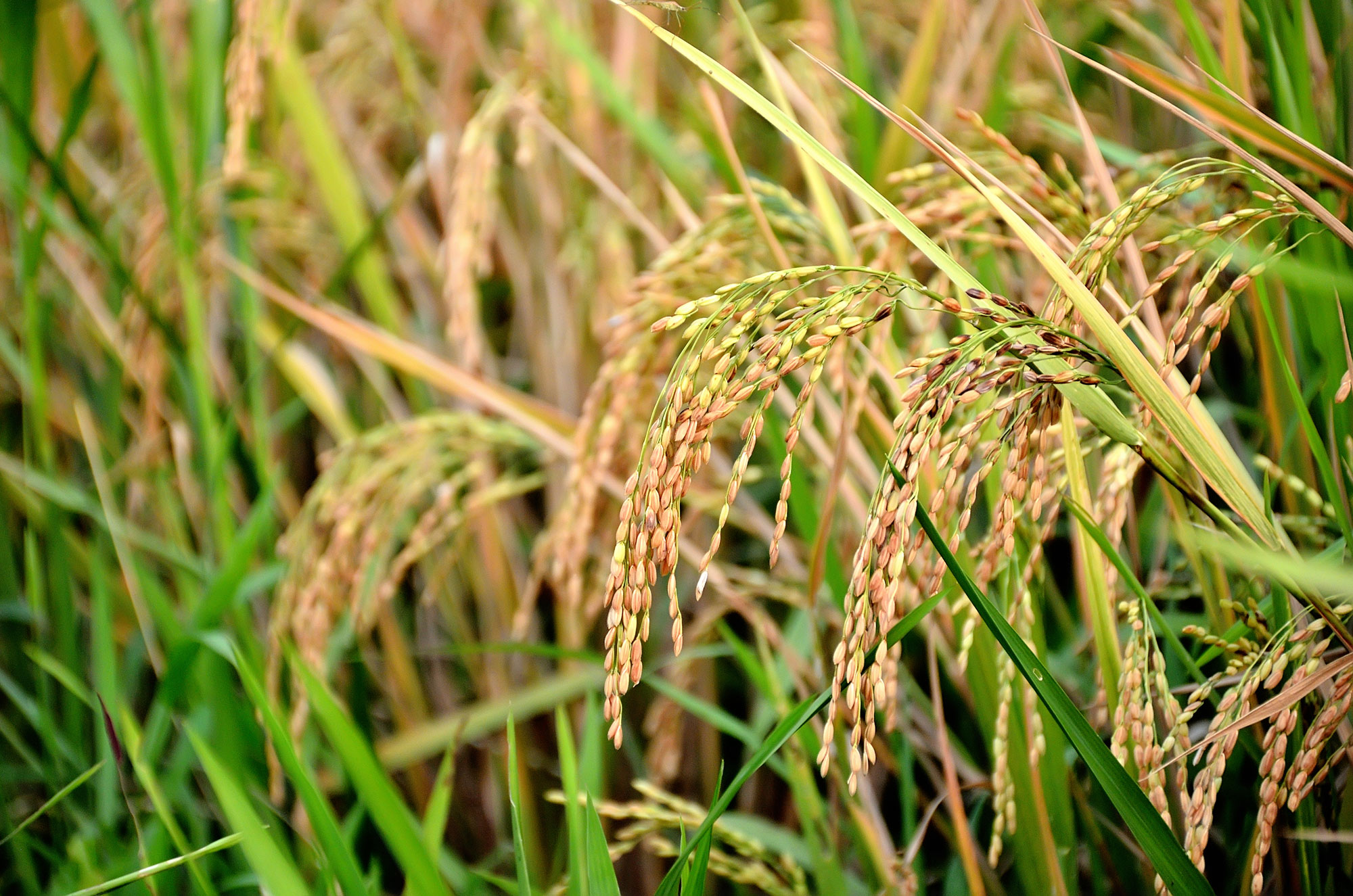
Cultivated rice (Oryza sativa), Kerala, India. Photo by Augustus Binu (Wikimedia Commons, Creative Commons Attribution-ShareAlike 3.0 Unported license, image resized).

Excerpt from original caption: "Members of the Leech Lake Band of the Ojibwe Tribe harvest rice on Mud Lake [Minnesota, U.S.A.], located on the Leech River, 17 miles downstream of Leech Lake Dam Sept. 3, 2015." Although not clear from the image, northern wild rice (Zizania palustris) is harvested by bending the plants over boats. The people visible in the photo are maneuvering shallow boats through water with poles; a seated partner in each boat knocks the rice into the bottom of the boat. Photo by George Stringham (U.S. Army Corps of Engineers on flickr, public domain).
Subfamily Bambusoideae (bamboos)
Bambusoideae are the bamboos. This is a large subfamily of grasses, with more than 100 genera and 1400 species. Bamboos are distributed worldwide and are found in the neotropics (American tropics), paleotropics (African and Asian to Australian tropics), and in temperate regions of eastern North America and eastern Asia. Bamboos are most diverse and abundant in Asia, although they are also very well represented in South America. While bamboos may be thought of as "woody" grasses, these plants do not produce true wood; nevertheless, many bamboos have stems with hard tissues that give them similar characteristics to true wood.
Bamboos are divided into three tribes. More than half of bamboo genera and species are tropical woody bamboos in the tribe Bambuseae, which includes more than 70 genera and perhaps more than 900 species. The temperate woody bamboos are in tribe Arundinarieae, which includes the eastern North American canes (Arundinaria), related eastern Asian species, and some bamboos from Africa and Madagascar. The smallest tribe is Olyreae, the herbaceous bamboos (also known as olyroid bamboos), which are primarily found in the Americas.
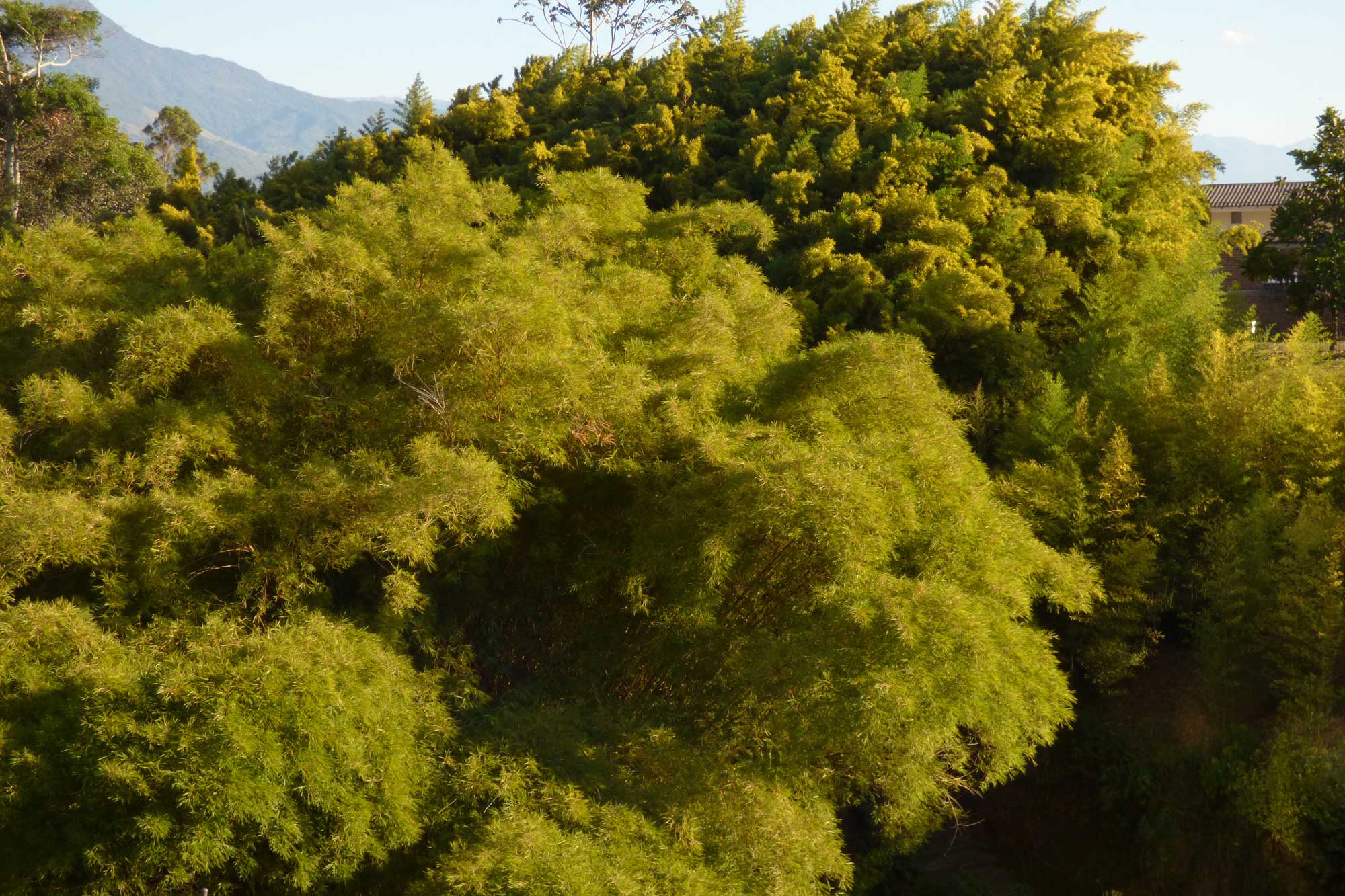
Guadual (Guada angustifolia), a tropical woody bamboo, Quindío, Colombia. Photo by Alejandro Bayer Tamayo (flickr, Creative Commons Attribution-ShareAlike 2.0 Generic license, image resized).
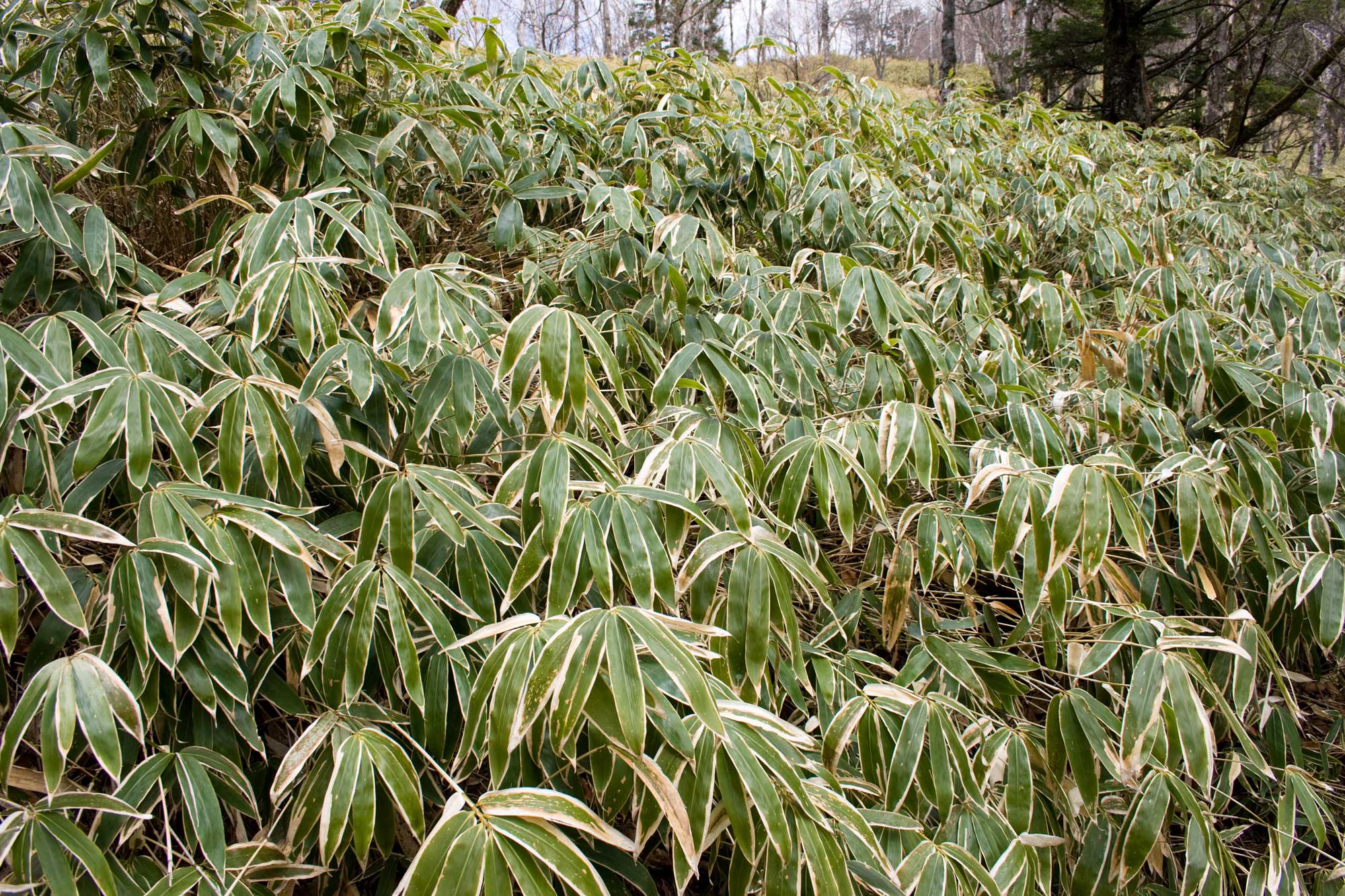
Kumazasa (Sasa veitchii), a temperate woody bamboo native to Japan. Photo by Σ64 (Wikimedia Commons, Creative Commons Attribution-ShareAlike 3.0 Unported license, image resized).
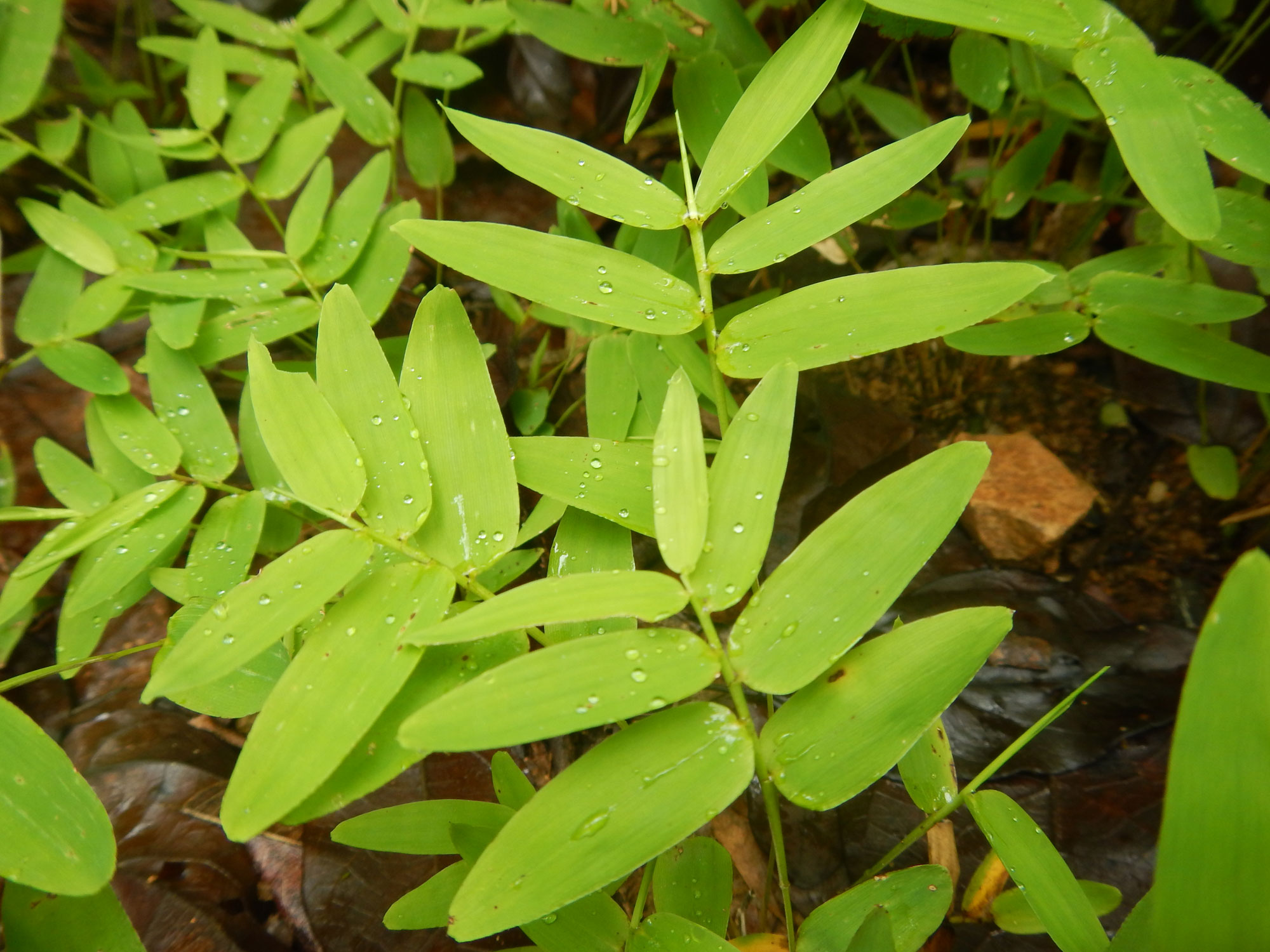
A herbaceous or olyroid bamboo (Raddia brasiliensis), Bahia, Brazil. Photo by Matt Lavin (flickr, Creative Commons Attribution-ShareAlike 2.0 Generic license, image resized).
Subfamily Pooideae (cool-season grasses)
Pooideae are the largest subfamily in the BOP clade, with more than 200 genera and 3900 species in 15 tribes; grasses from this subfamily are found all over the world, although they are mostly temperate.
Most members of subfamily Pooideae are in tribe Poeae, which includes about 120 genera and more than 2500 species, among them species of bentgrass (Agrostis), oat (Avena), reed grass (Calamagrostis), orchard grass (Dactylis), fescue (Festuca and Vulpia), timothy (Phleum), bluegrass (Poa), alkali grass (Puccinellia), and oatgrass (Trisetum).
Tribe Triticeae (27 genera, about 500 species) includes the economically important cereal crops barley (Hordeum vulgare), rye (Secale cereale), and wheat (Triticum). Other types of grasses in subfamily Pooideae include brome or cheat grass (Bromus) and needlegrass (Stipa).
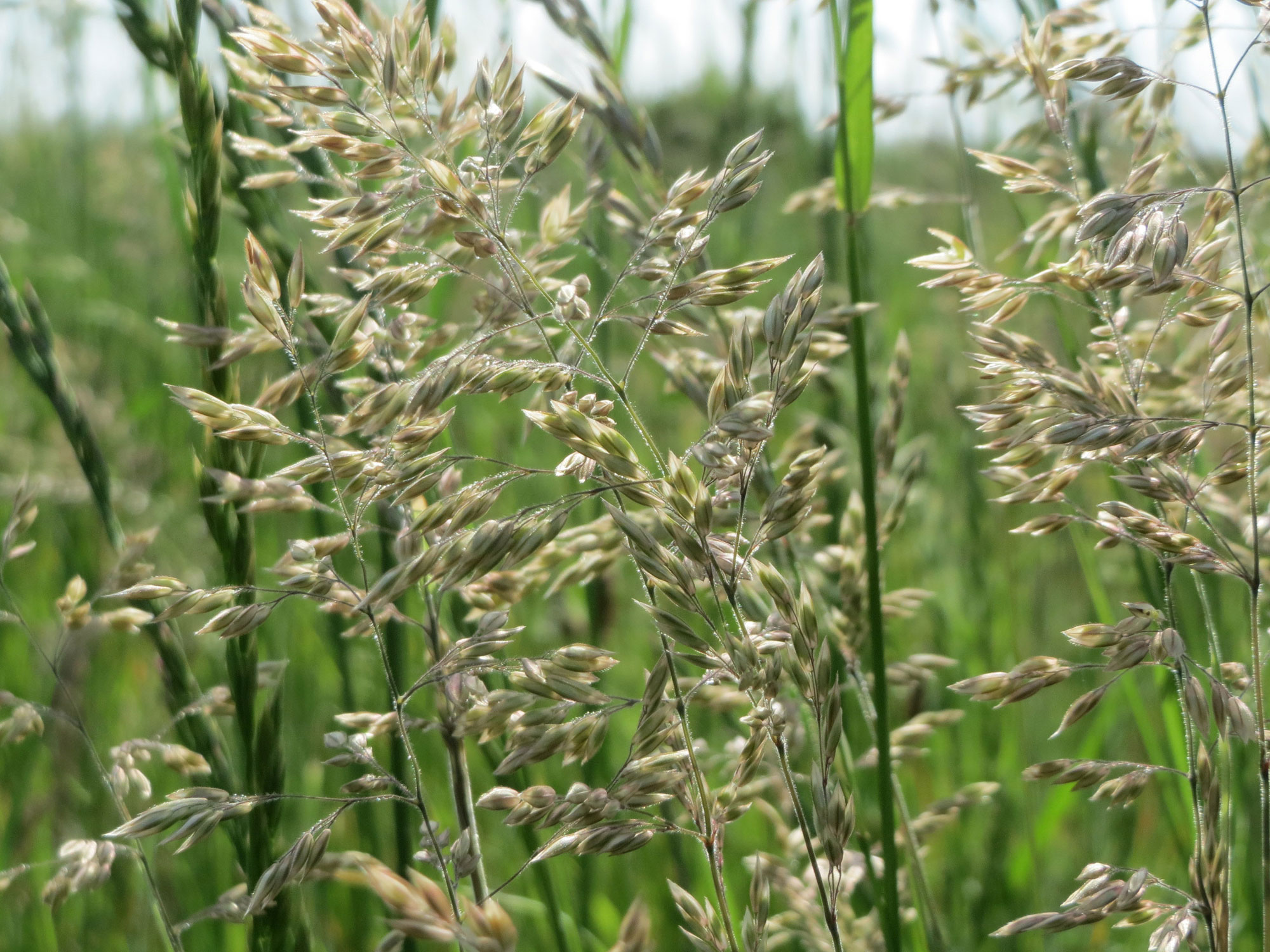
Kentucky bluegrass (Poa pratensis), Hockenheim, Germany. Despite its common English name, Kentucky bluegrass is native to North Africa and Eurasia. Photo by AnRo0002 (Wikimedia Commons, Creative Commons CC0 1.0 Universal/public domain dedication).
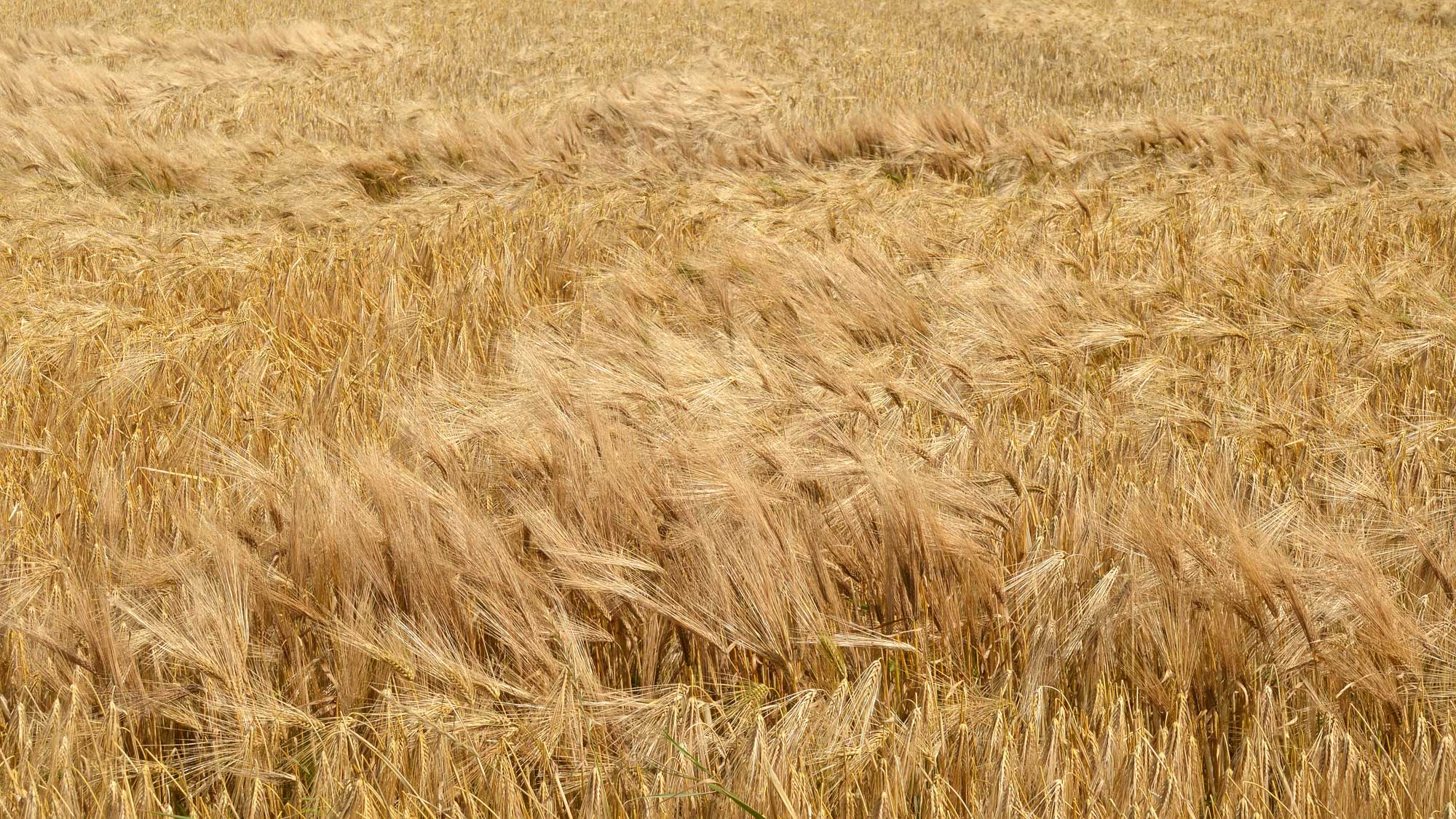
Barley (Hordeum vulgare), Hå, Norway. Photo by Ryan Hodnett (Wikimedia Commons, Creative Commons Attribution-ShareAlike 4.0 International license, image resized).
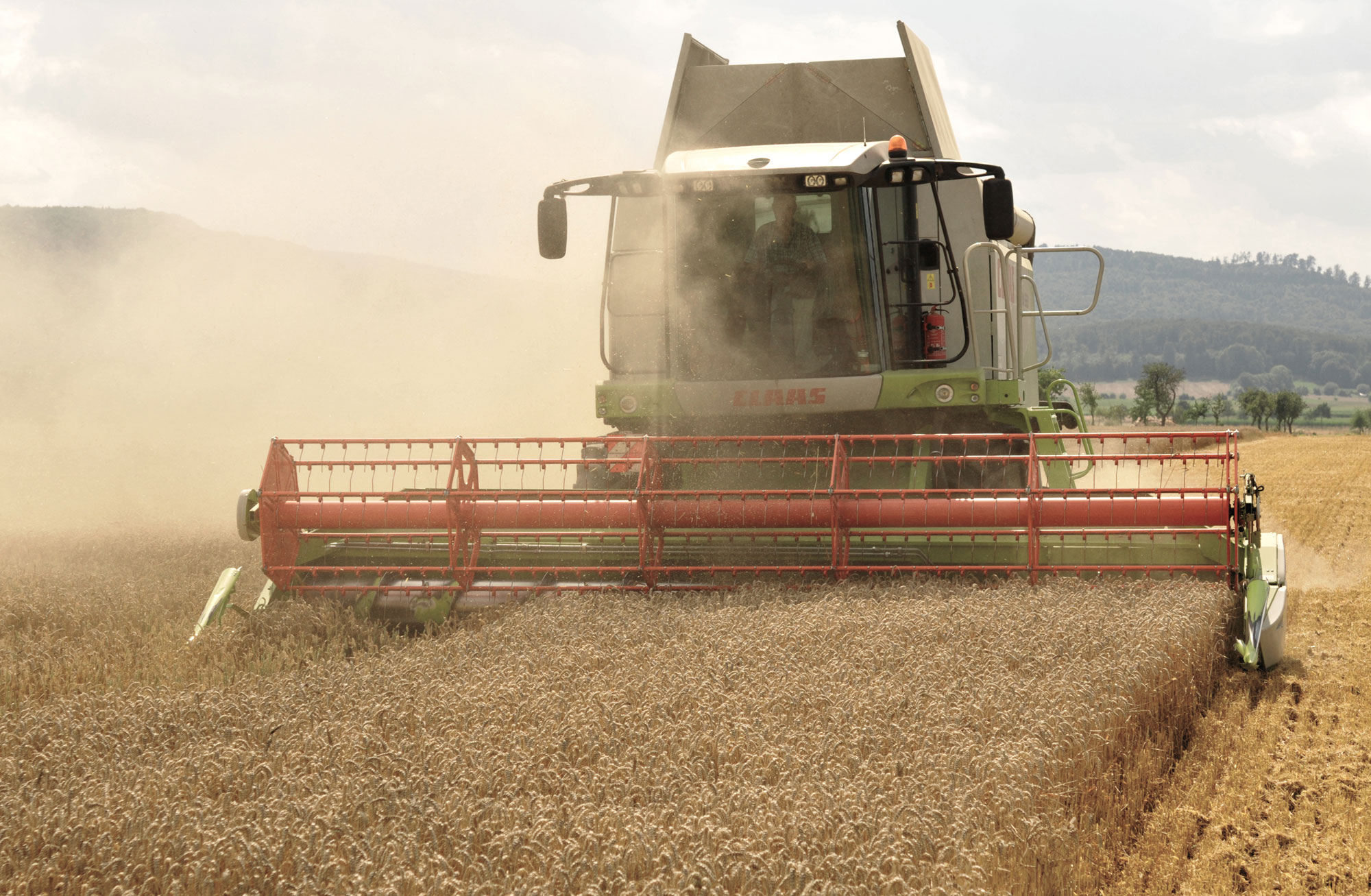
A combine harvesting wheat, Eldagsen region, Germany. Photo by Michael Gäbler (Wikimedia Commons, Creative Commons Attribution-ShareAlike 3.0 Unported license, image resized).
PACMAD clade
The "PACMAD" clade is named for the six subfamilies that make up the group: Panicoideae, Aristidoideae, Chloridoideae, Micrairoideae, Arundinoideae, and Danthonioideae. PACMADs include C3 and C4 grasses.
Subfamily Aristidoideae
Subfamily Aristidoideae includes three genera and more than 350 species mostly found in the tropics. The lemma of the florets in this subfamily have three awns (pointed extensions), which gives the three awn (genus Aristida) one of its common names. These grasses generally grow in dry environments and disturbed areas. Most Aristidoideae are C4 grasses.
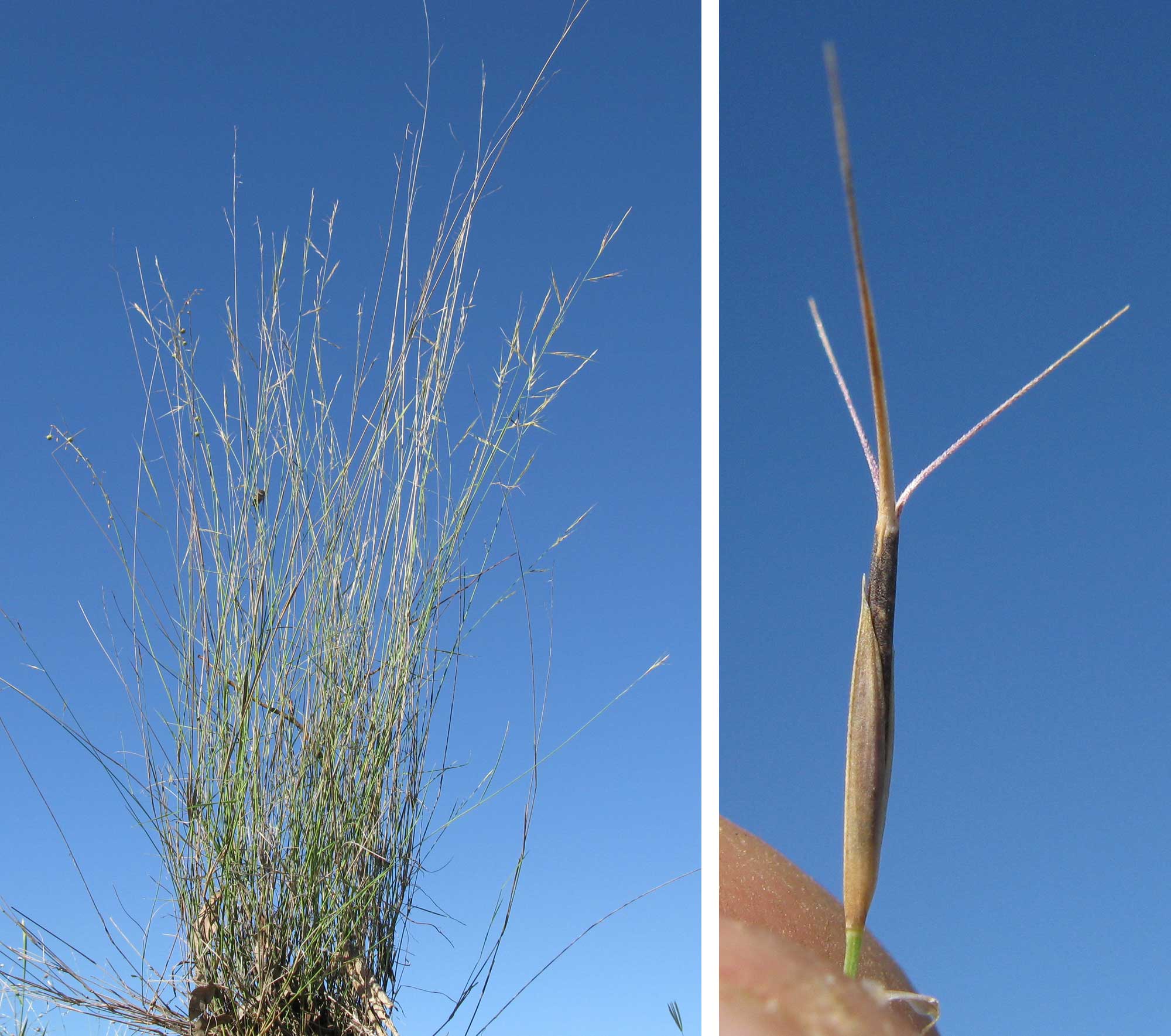
Purple wire grass (Aristida personata), New South Wales, Australia. Left: Overall view of the plant. Right: Spikelet with three awns (pointed extensions). Left photo and right photo by Harry Rose (flickr, Creative Commons Attribution 2.0 Generic license, images cropped and resized).
Subfamily Panicoideae
Subfamily Panicoideae is among the largest subfamilies of grasses, with nearly 250 genera and more than 3200 species in 14 tribes; many are C4 grasses.
The largest tribe in Panicoideae is tribe Paniceae (about 80 genera and more than 1200 species). This tribe includes regionally important crops like Pearl millet (Cenchrus americanus) and foxtail millet (Setaria italica), grown in parts of Africa and Asia, as well as Proso millet (Panicum millaceum) from Eurasia. Examples of other members of this tribe are crabgrass (Digitaria), satintail (Imperata), panicgrass (Panicum), fountaingrass (Pennisetum), and signalgrass (Urochloa).
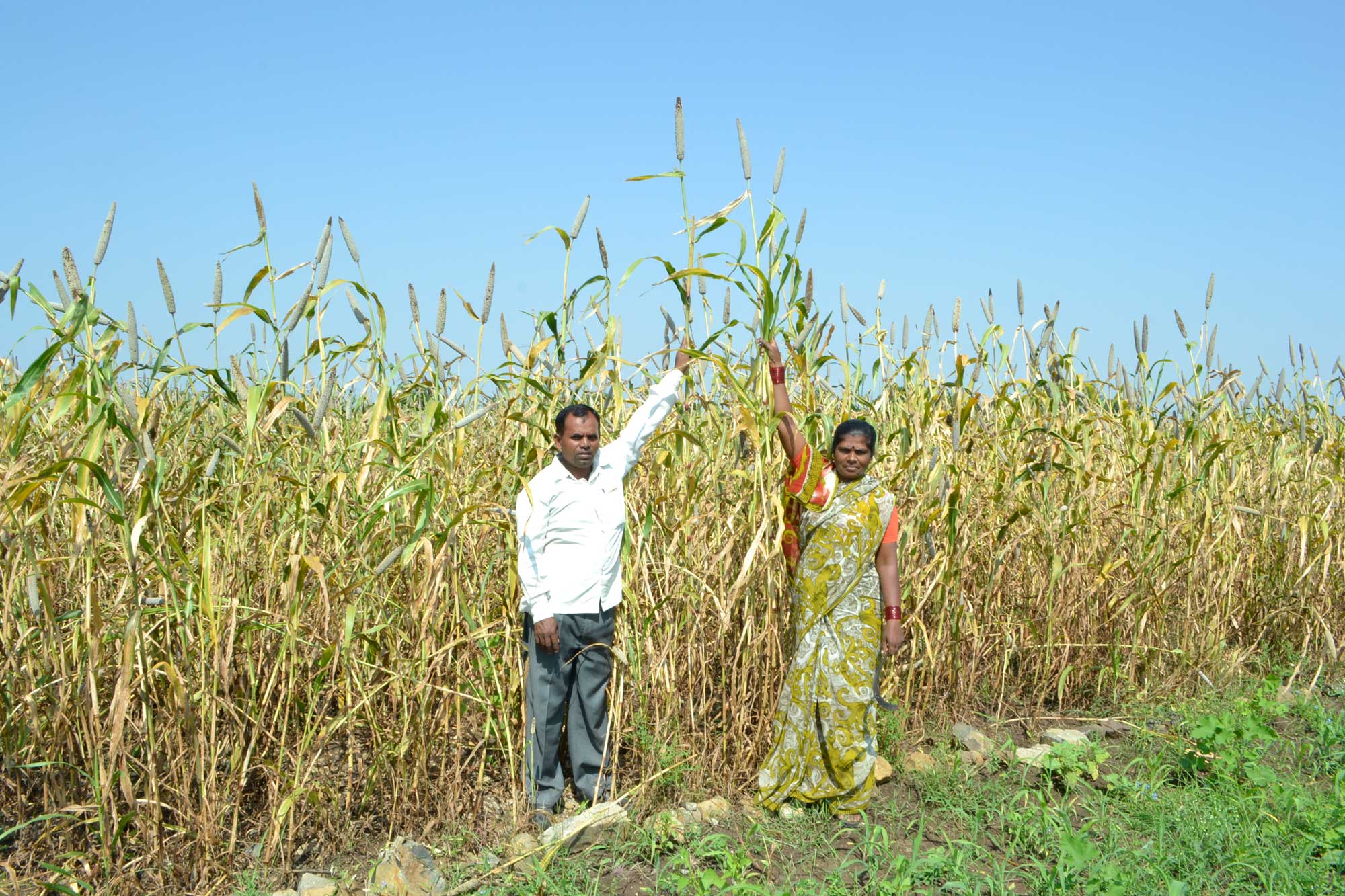
Field of pearl millet (Cenchrus americanus) in Aurangabad, Maharashtra, India. Photo by - शांताराम पंदेरे, लोकपर्याय (Lokparaya, Loni-Khu Ta. Vaijapur, Dist. Aurangabad-Shantaram Pandere, Creative Commons Attribution-ShareAlike 4.0 International license, image resized).
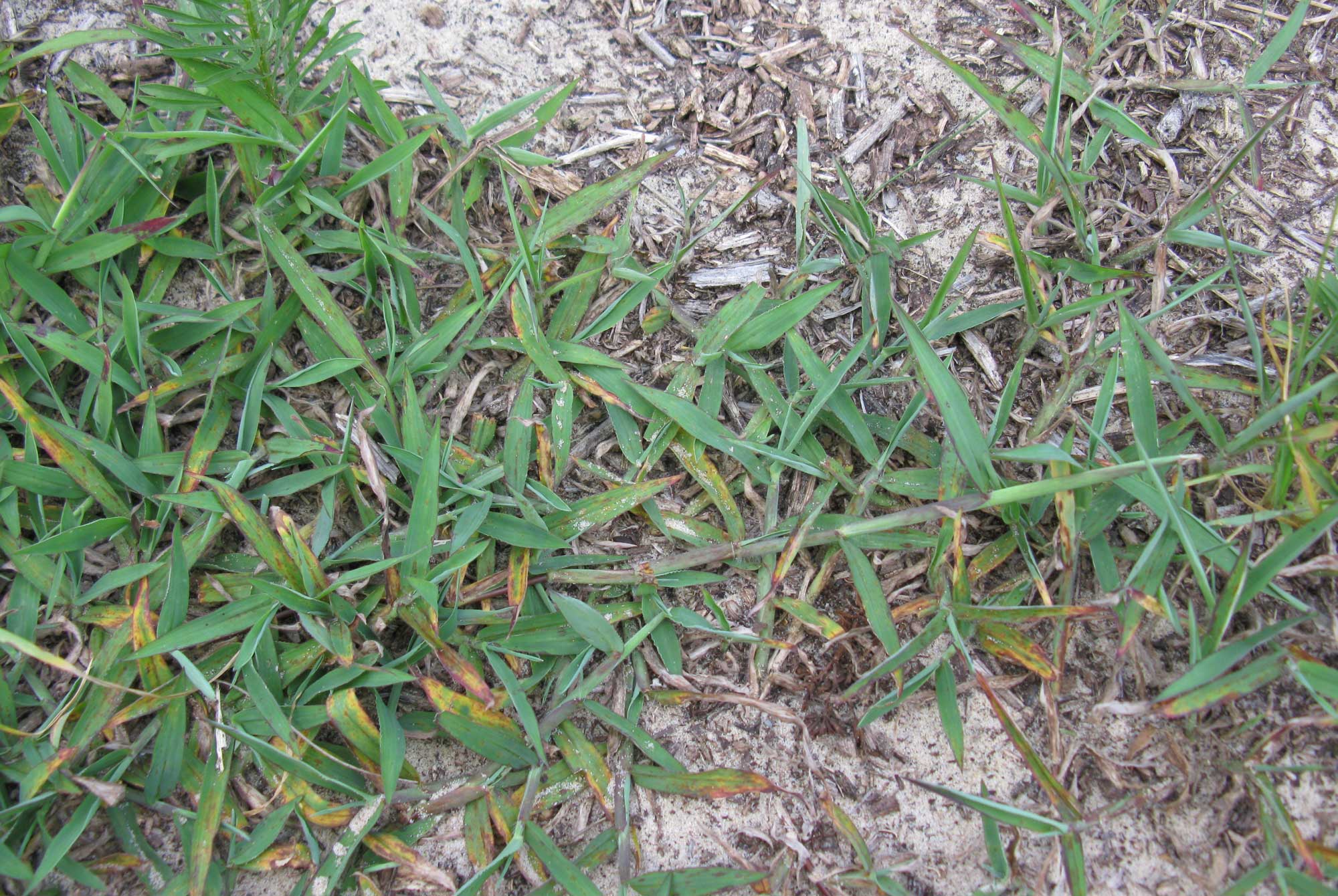
Crab grass (Digitaria sanguinalis), New South Wales, Australia. Photo by Harry Rose (flickr, Creative Commons Attribution 2.0 Generic license, image cropped and resized).
One of the most economically important tribes in subfamily Panicoideae is Androponogoneae (98 genera, more than 1200 species), which is named after the bluestem (Andropogon). This tribe includes maize or corn (Zea mays), the most widely grown cereal crop in the world, as well as sorghum (Sorghum bicolor), which ranks fifth among cereals. Sugar cane (Saccharum officinarum), one of the major sources of table sugar (sucrose), is also in this tribe.

Ears of different corn varieties from Mexico. Photo by Feria de Productores on flickr (Creative Commons Attribution 2.0 Generic license, image cropped and resized).

Sugar cane (Saccharum officinarum) at a farmer's market in California, U.S.A. Photo by Franco Folini (flickr, Creative Commons Attribution-ShareAlike 2.0 Generic license, image resized).
Examples of other grasses in subfamily Panicoideae include wild cane (Gynerium sagittatum), which has many uses (for example, this grass is used to make arrows, hats, and mats); the grain crop Kodo millet (Paspalum scrobiculatum) from India; and tiger grass (Thysanolaena latifolia), which is used an an ornamental and to make food wrappings and brooms in parts of Asia.
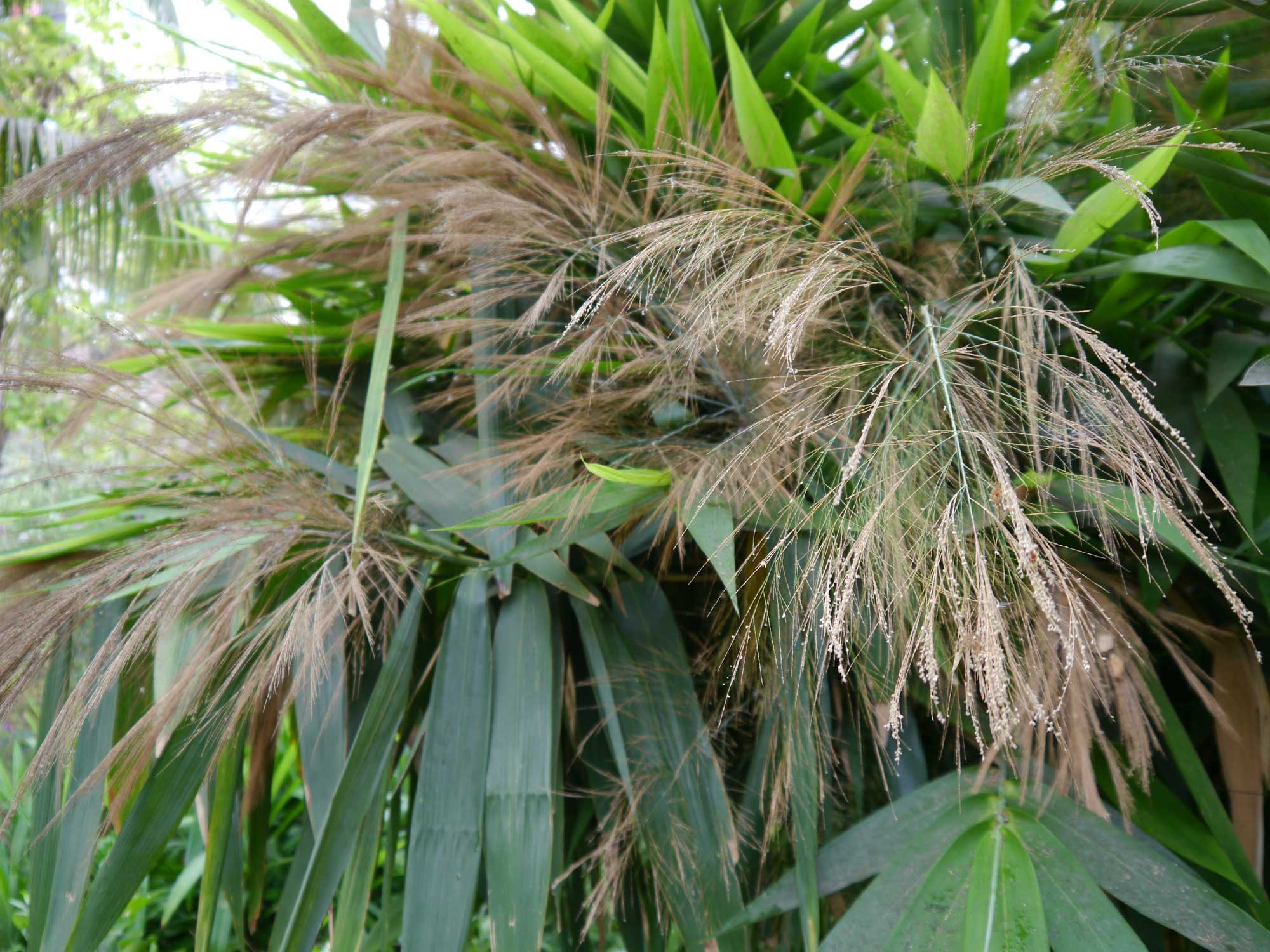
Tiger grass (Thysanolaena latifolia), cultivated, India. Photo by Dinesh Valke (flickr, Creative Commons Attribution-ShareAlike 2.0 Generic license, image resized).
Subfamily Arundinoideae
Subfamily Arundinoideae includes about 14 genera and 40 species of C3 grasses divided between two tribes. Among members of this subfamily are the reeds (Arundo and Phragmites), which include the widespread grasses giant reed (Arundo donax) and common reed (Phragmites australis).
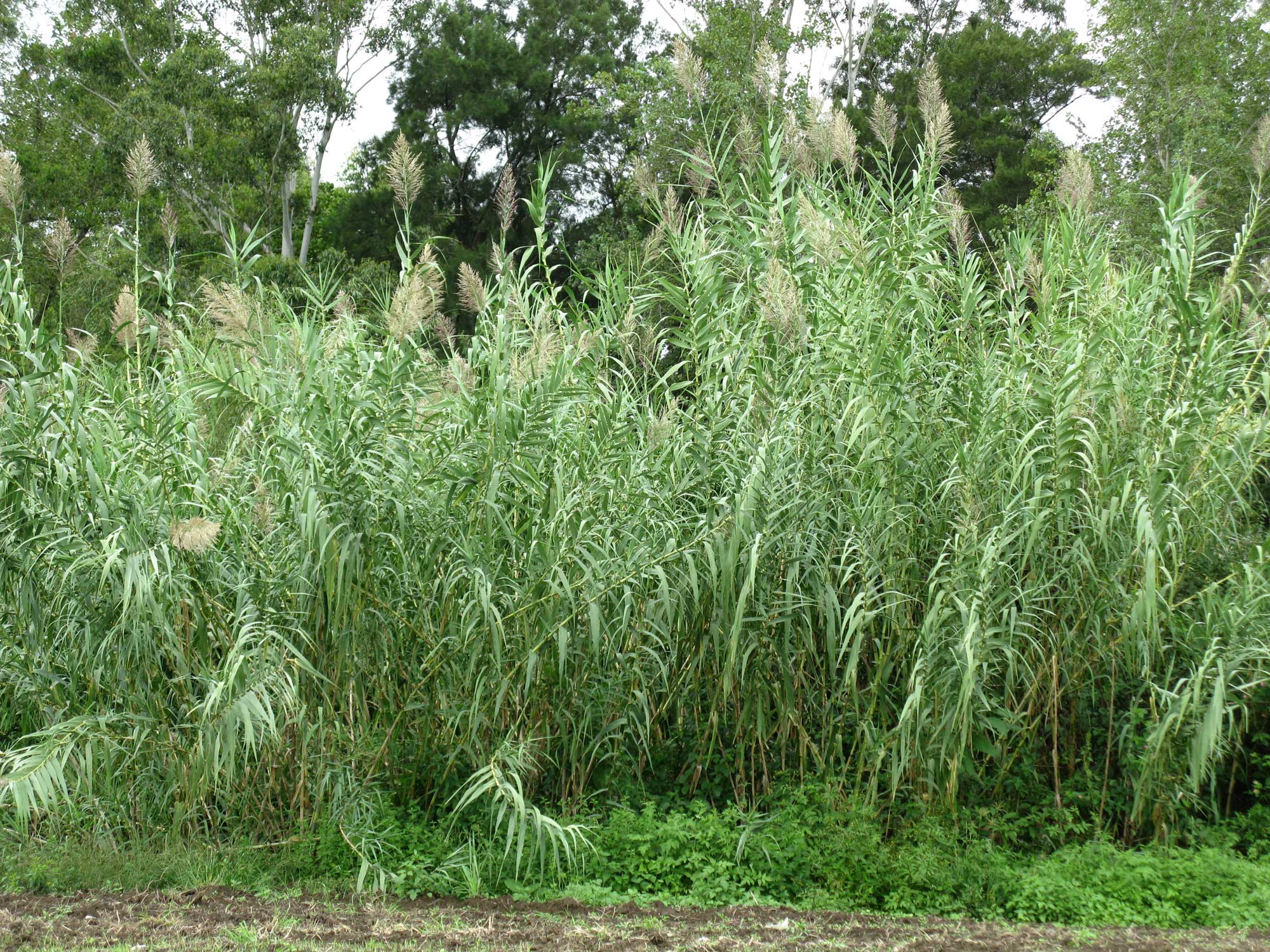
Giant reed (Arundo donax), New South Wales, Australia. Photo by Harry Rose (flickr, Creative Commons Attribution 2.0 Generic license, image resized).
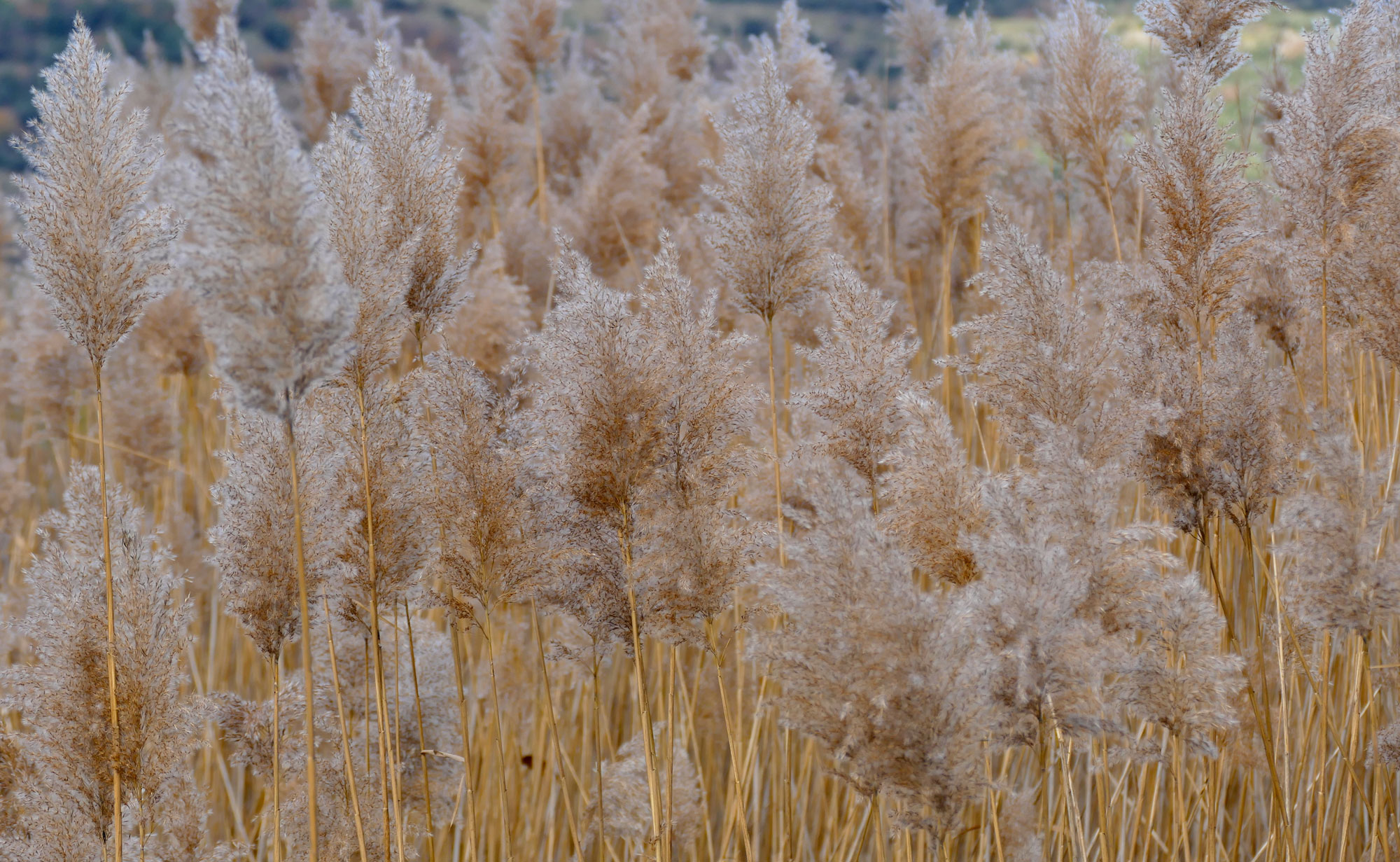
Common reed (Phragmites australis), Salagou Lake, France. Photo by Bernard Dupont (flickr, Creative Commons Attribution-ShareAlike 2.0 Generic license, image resized).
Subfamily Micrairoideae
Subfamily Micrairoideae includes about 8 genera and more than 180 species in four tribes. Two genera of Micrairoideae (Eriachne and Pheidochloa) are C4 grasses. Examples of members of this subfamily are Wanderrie grass (Eriachne) and bloodgrass (Isachne).
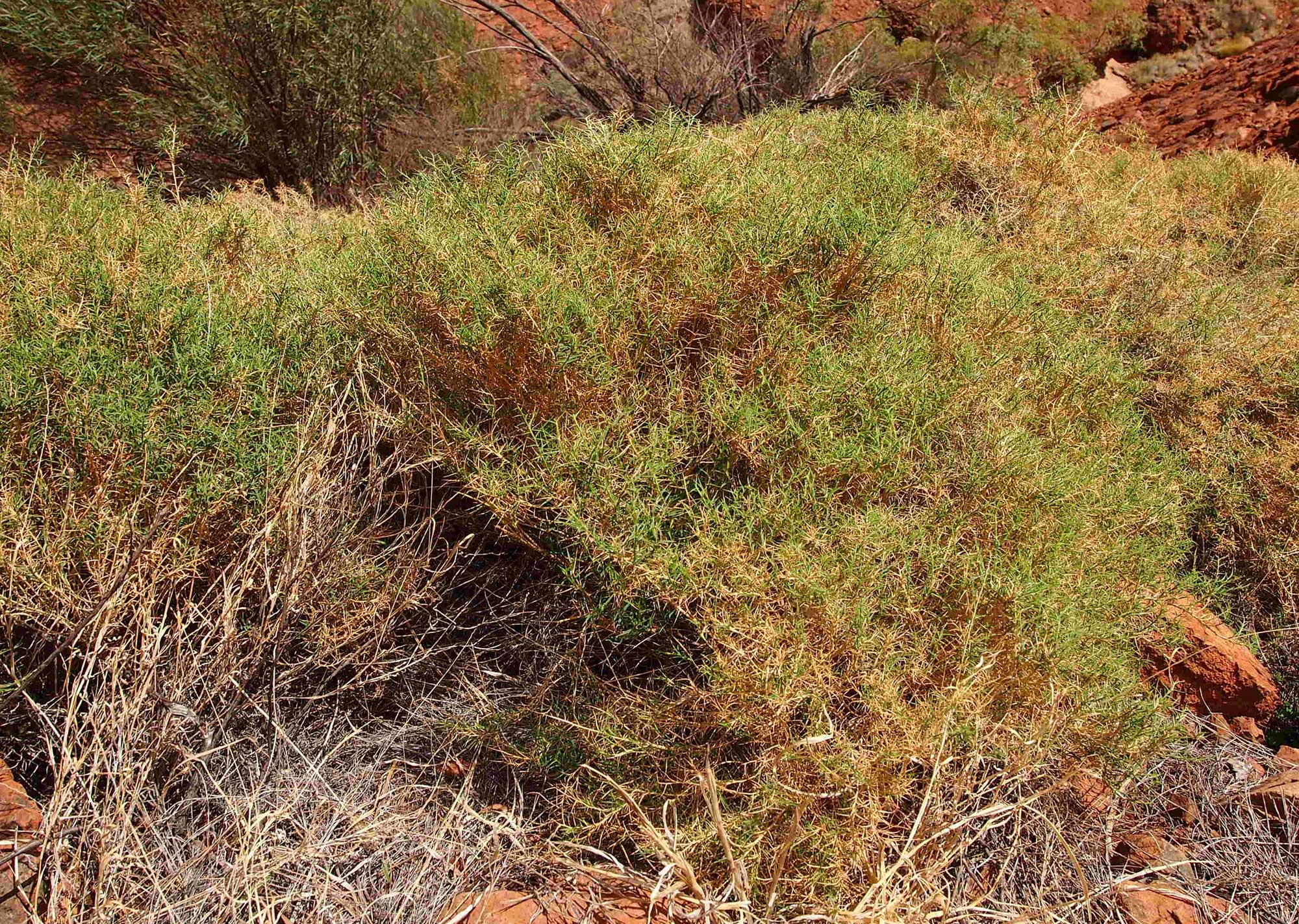
Wanderrie grass (Eriachne scleranthoides), Uluru-Kata Tjuta National Park, Australia. Photo by Mark Marathon (Wikimedia Commons, Creative Commons Attribution-ShareAlike 4.0 International license, image resized).
Subfamily Danthonioideae
Subfamily Danthonioideae includes C3 grasses, with about 20 genera and more than 290 species in one tribe. Members of this family are adapted to cool environments. Examples of grasses in this subfamily are pampas grass (Cortaderia) and oatgrass (Danthonia).
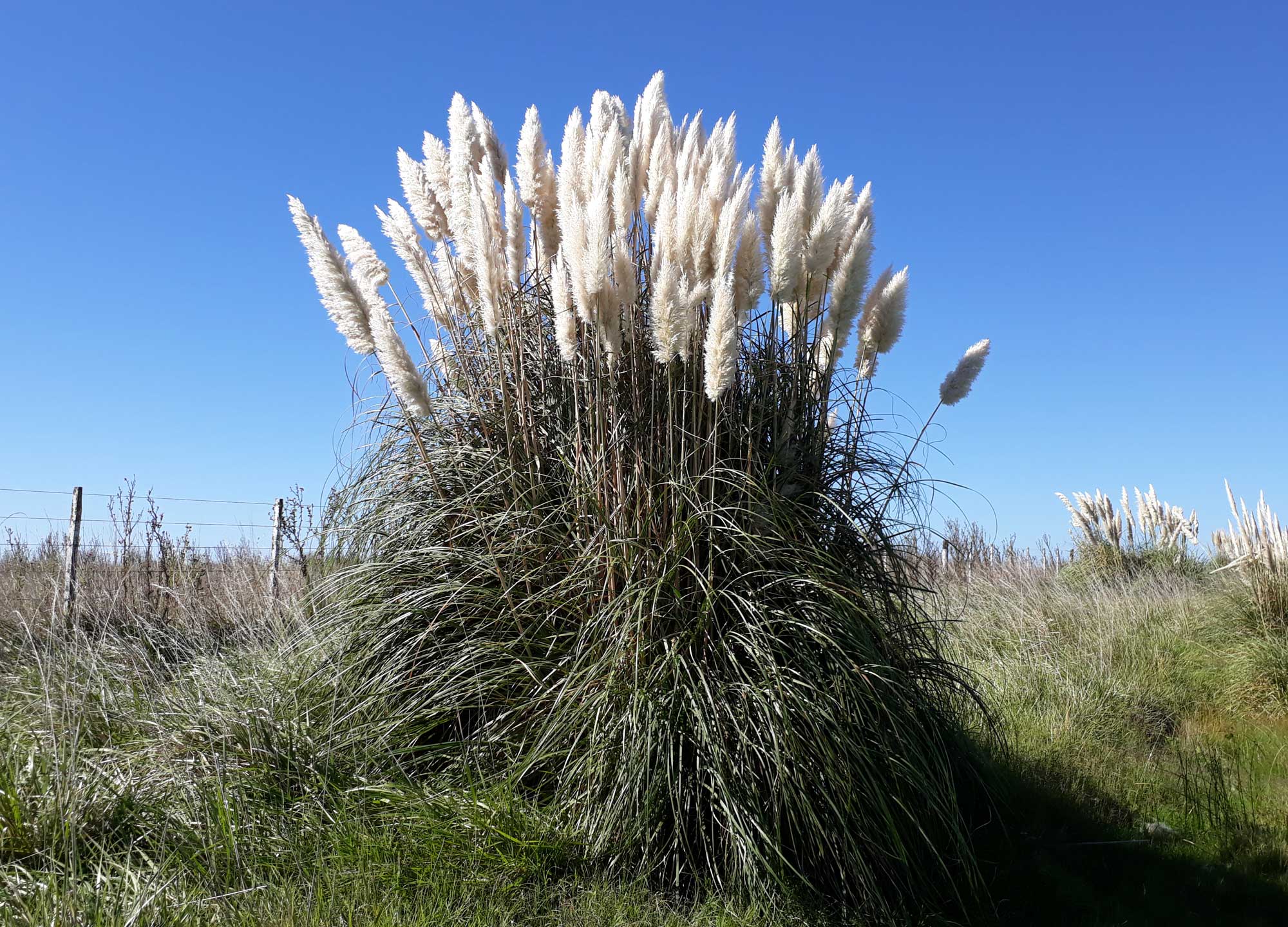
Pampas grass (Cortaderia selloana), Argentina. Photo by Fernando de Gorocica (Wikimedia Commmons, Creative Commons Attribution-ShareAlike 4.0 International license, image cropped and resized).
Subfamily Chloridoideae
Chloridoideae are a large subfamily of mostly C4 grasses, with nearly 125 genera and more than 1600 species in five tribes.
More than half of grasses in this subfamily are in tribe Cynodonteae (94 genera, 850 species), which includes buffalograss (Buchloe dactyloides), Bermuda grass (Cynodon), goosegrass (Eleusine), and sprangletop (Leptochloa). Finger millet (Eleusine coracana) is a regionally important crop in parts of Africa and Asia.
Tribe Eragrostideae has about 14 genera and more than 480 species. It includes teff (Eragrostis tef), an important grain crop in Ethiopia and Eritrea, and other lovegrasses (Eragrostis).

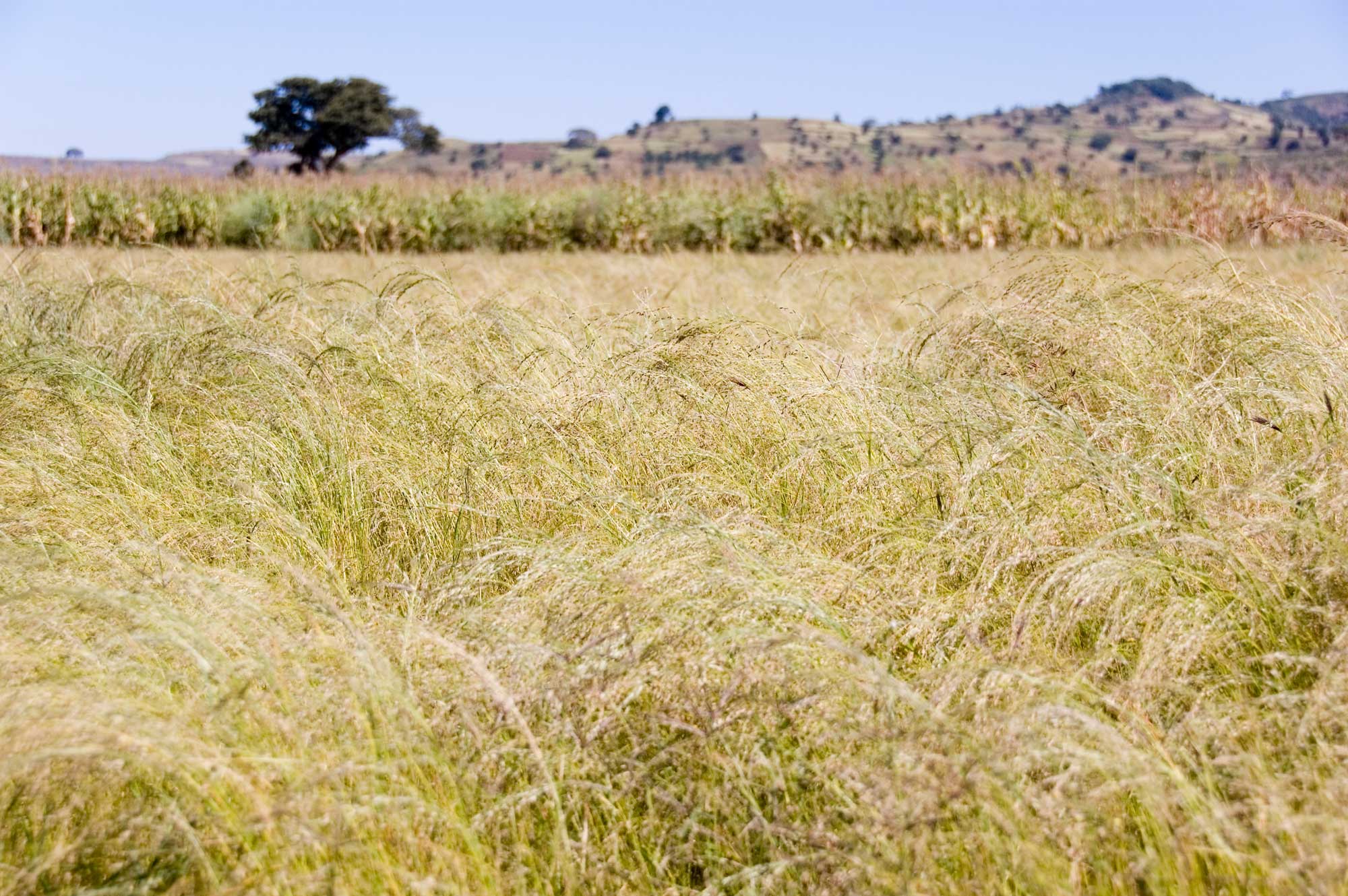
A field of teff (Eragrostis tef), Ethiopia. Photo by A.Davey (flickr, Creative Commons Attribution 2.0 Generic license, image resized).
Resources
Websites
Angiosperm Phylogeny Website (P. F. Stevens): http://www.mobot.org/MOBOT/research/APweb/
GrassWorld: https://grassworld.myspecies.info/en
Scientific articles and books
Grass Phylogeny Working Group. 2001. Phylogeny and subfamilial classification of the grasses (Poaceae). Annals of the Missouri Botanical Garden 88: 373-457. https://doi.org/10.2307/3298585
Kellogg, E. A. 2015. Flowering Plants, Monocots, Poaceae. The Families and Genera of Vascular Plants 13, 416 pp. (K. Kubitzki, ed.). Springer International Publishing, Switzerland. https://doi.org/10.1007/978-3-319-15332-2_1
Soreng, R. J., P. M. Peterson, K. Romaschenko, G. Davidse, J. K. Teisher, L. G. Clark, P. Barberá, L. J. Gillespie, and F. O. Zuloaga. 2017. A worldwide phylogenetic classification of the Poaceae (Gramineae) II: An update and a comparison to two 2015 classifications. Journal of Systematics and Evolution 55: 259-290. https://doi.org/10.1111/jse.12262
Yeasmin, L, Md. N. Ali, S. Gantait, and S. Chakraborty. 2014. Bamboo: an overview on its genetic diversity and characterization. 3 Biotech 5: 1-11. https://doi.org/10.1007/s13205-014-0201-5



